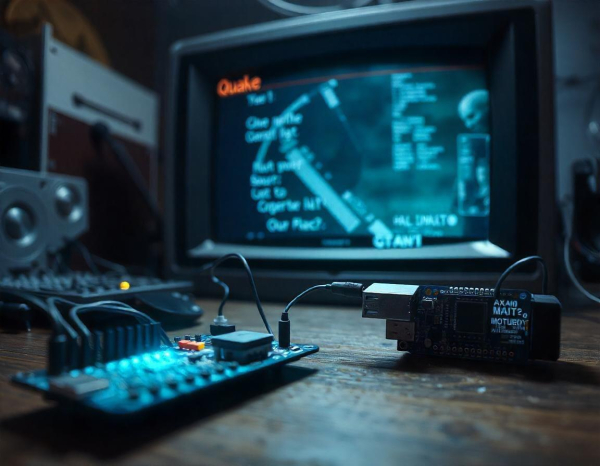Suche
Beiträge, die mit quake getaggt sind
https://earthquake.usgs.gov/earthquakes/eventpage/tx2025ggzf
https://earthquake.usgs.gov/earthquakes/eventpage/us7000pnw6

Myanmar earthquake: Death toll rises to 1644, rescue efforts underway
A unilateral partial ceasefire to facilitate earthquake relief efforts has been announced by Myanmar’s shadow National Unity Government. The resistance movement coordinates the popular struggle against the ruling military.Grant Peck (AP News)
#quake #myanmar #climateChange #earthquakes
https://www.livescience.com/planet-earth/earthquakes/will-we-have-more-earthquakes-because-of-climate-change

Will we have more earthquakes because of climate change?
Changes in sea level and glacial melt could make earthquakes more likely in the coming years.Katherine Irving (Live Science)
Nicola Wrachien with Silicon Labs created this fun handheld, porting Quake using the Arduino Nano Matter. For easy playing a custom controller shaped board was designed with joysticks and a screen.
https://next-hack.com/index.php/2024/09/22/quake-port-to-sparkfun-and-arduino-nano-matter-boards-using-only-276-kb-ram/
#quake #arduino #nano #diy #handheld #port #retro #gaming #art #maker #engineer #artist #media #programming #tech #news
https://flip.it/liu_RR
#Greece #Santorini #Earthquakes #Disaster #Quake

Greece earthquakes: Aftershocks hit Santorini and surrounding islands
Three more quakes above 4.0 magnitude are registered on Monday near the Greek tourist hotspot.Nikos Papanikolaou and Robert Greenall (BBC News)


![[ImageSource: Nicola Wrachien]
For a much tougher challenge, a group from Silicon Labs decided to port DOOM‘s successor, Quake, to the Arduino Nano Matter Board platform instead even though this platform has some pretty significant limitations for a game as advanced as Quake.
<https://community.silabs.com/s/share/a5UVm000000Vi1ZMAS/quake-ported-to-arduino-nano-matter-and-sparkfun-thing-plus-matter-boards?language=en_US>
To begin work on the memory problem, the group began with a port of Quake originally designed for Windows, allowing them to use a modern Windows machine to whittle down the memory usage before moving over to hardware. They do have a flash memory module available as well, but there’s a speed penalty with this type of memory. To improve speed they did what any true gamer would do with their system: overclock the processor. This got them to around 10 frames per second, which is playable, but not particularly enjoyable.
The further optimizations to improve the FPS required a much deeper dive which included generating lookup tables instead of relying on computation, optimizing some of the original C programming, coding some functions in assembly and only refreshing certain sections of the screen when needed. [ImageSource: Nicola Wrachien]
For a much tougher challenge, a group from Silicon Labs decided to port DOOM‘s successor, Quake, to the Arduino Nano Matter Board platform instead even though this platform has some pretty significant limitations for a game as advanced as Quake.
<https://community.silabs.com/s/share/a5UVm000000Vi1ZMAS/quake-ported-to-arduino-nano-matter-and-sparkfun-thing-plus-matter-boards?language=en_US>
To begin work on the memory problem, the group began with a port of Quake originally designed for Windows, allowing them to use a modern Windows machine to whittle down the memory usage before moving over to hardware. They do have a flash memory module available as well, but there’s a speed penalty with this type of memory. To improve speed they did what any true gamer would do with their system: overclock the processor. This got them to around 10 frames per second, which is playable, but not particularly enjoyable.
The further optimizations to improve the FPS required a much deeper dive which included generating lookup tables instead of relying on computation, optimizing some of the original C programming, coding some functions in assembly and only refreshing certain sections of the screen when needed.](https://friendica-leipzig.de/photo/preview/600/806495)